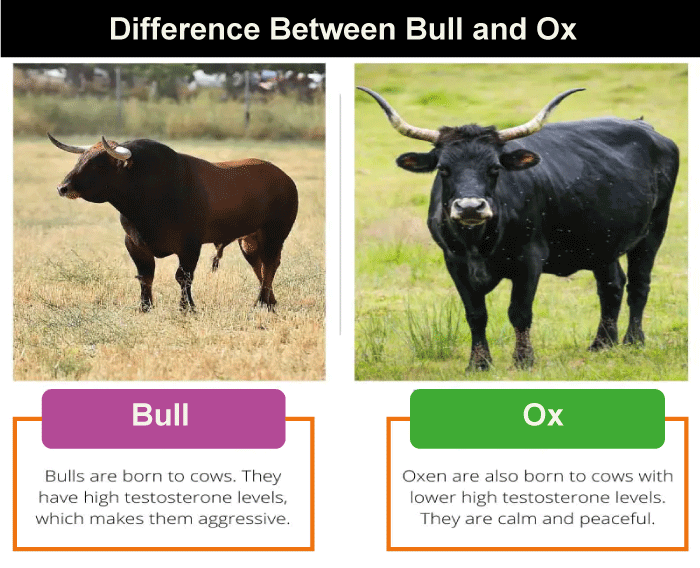Difference Between Ox and BullIntroduction"Ox" and "Bull" refer to all bovines, including moose, buffalo, and other members of the Bos taurus, or cattle, species. These are male cows, yet they differ greatly from one another. 
The most common definition of an ox is a beast of burden. Although not particularly aggressive, they are utilized for tasks like transporting big objects, irrigating by running pumps, and ploughing fields. Oxen are mostly utilized on farms as draught animals. The most typical way that oxen are used to pull heavy loads and cargo is in pairs of two in carts. Bulls are incredibly aggressive, making it nearly impossible to control them. Compared to an ox, the body and build of a bull are much heavier and more muscular. It has larger bones, a robust neck, and a large head with guarding ridges over the eyes. They are much heavier than oxen. BullA male Bos taurus animal, fully grown and uncastrated, is called a bull. To breed with females and expand the number of domesticated cattle, farmers use these huge, muscular bovine animals as studs. Bulls can be influenced by their hormones and are frequently challenging to control because their reproduction ability has not been hindered. They are often kept alone in their pastures and not used for riding or ploughing until it is time for them to breed with cows and heifers. They have no other function outside reproduction. Thus, they are more likely to be killed for meat before puberty. Most farmers only need a small number of bulls, and they could be too aggressive to manage. Bulls are significant as they aid in reproducing new cows, which produce dairy, beef, and additional livestock. OxEven though the term "ox" most frequently refers to a castrated bull of a Bos taurus species of animal, it can also refer to any fully matured drafts or riding cattle, even females. They are far more docile (ready to accept control or instruction) than bulls since these adult male cattle have been neutered (castrated), which prevents them from mating or breeding with female cattle. To prepare fields for crop planting, farmers mostly use oxen to plough fields, pull bullock carts, and prepare grains. They are paired off into groups known as oxen. Oxen are mainly castrated while young before they attain a year of age, as keeping them intact beyond it can result in them turning very aggressive and challenging to manage. Oxen are considerably more peaceful animals and can be housed with other livestock and females ready for mating because they get along with other individuals. Oxen are extremely valuable animals typically not killed for their meat since they can plough fields, carry heavy loads when transporting products, grind grains, and do other labor-intensive tasks. In a few exceptional cases, castrated bulls are replaced with cows instead of oxen. However, this isn't common, as the word oxen describe mostly adult male cattle. Difference between ox and bullWhile bulls and oxen are born into the cow's family and can be considered members of the same species, several physical variations between them become more apparent as they grow. Oxen are the larger of the two male cattle breeds, but bulls are much heavier and more muscular because of their broader necks and heavier bones. While comparing the two, it is simple to see the difference between them and tell whether or not they have been castrated by checking near their hind legs. Compared to bulls with more developed forebodies, oxen have more muscular and powerful rear bodies because they undergo castration earlier in life. Due to the different levels of testosterone they have due to the castration, there is also a significant difference in their temperament. Bulls are far more aggressive and challenging to control. Their actions are frequently erratic, and they have been known to gore (frighten) other cattle or people who get in their way with their horns when they become particularly aggressive. Because of this, it is advised to keep them apart. Once they have used up all their energy moving around, they are also renowned for being lazy. Oxen are employed for riding, pulling large loads when moving products as draught animals, and other labor-intensive duties since they are calm and dependable. They can also be used to plough fields. They can be kept in couples or big groups and are generally docile and non-aggressive. Since they are highly durable and easily adaptive, they can operate continuously for almost a day without frustration or exhaustion. Domestic bulls and oxen have meat that is very different from other animals. Oxen may still be used for meat despite being far less likely to be killed than bulls if there are too many of them or if they can no longer work. Bulls and oxen have drier and harder meat than cows and heifers. The uncooked meat of bulls has an unpleasant odor and is leaner and more muscular. Because of the high-fat content of oxen, its flesh is juicier and more tender. This is a result of their reduced testosterone levels due to castration. In contrast to bulls and oxen, which are types of cattle that have not been bred for this purpose, beef breeds have been developed specifically for tenderness and quality.
Conclusion
Next TopicDifference between
|
 For Videos Join Our Youtube Channel: Join Now
For Videos Join Our Youtube Channel: Join Now
Feedback
- Send your Feedback to [email protected]
Help Others, Please Share










